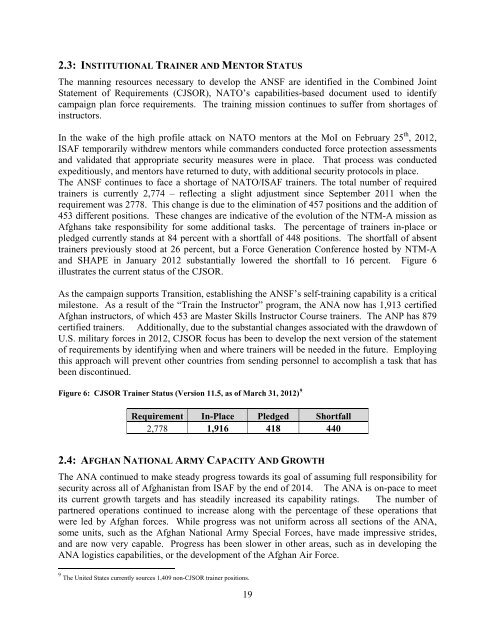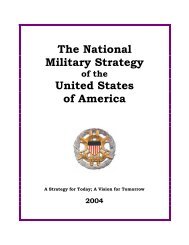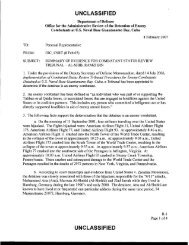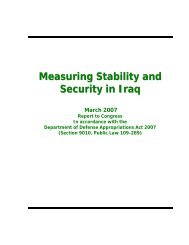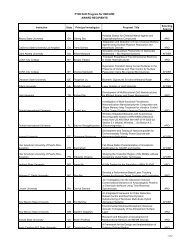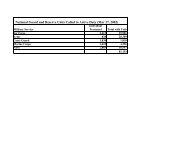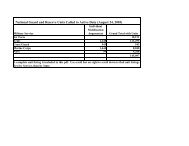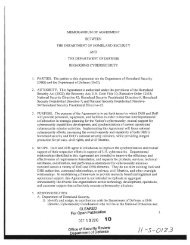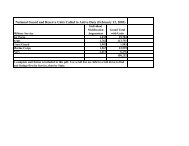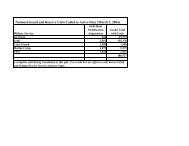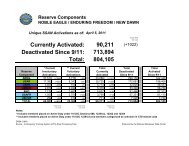Report on Progress Toward Security and Stability in - United States ...
Report on Progress Toward Security and Stability in - United States ...
Report on Progress Toward Security and Stability in - United States ...
Create successful ePaper yourself
Turn your PDF publications into a flip-book with our unique Google optimized e-Paper software.
2.3: INSTITUTIONAL TRAINER AND MENTOR STATUS<br />
The mann<strong>in</strong>g resources necessary to develop the ANSF are identified <strong>in</strong> the Comb<strong>in</strong>ed Jo<strong>in</strong>t<br />
Statement of Requirements (CJSOR), NATO’s capabilities-based document used to identify<br />
campaign plan force requirements. The tra<strong>in</strong><strong>in</strong>g missi<strong>on</strong> c<strong>on</strong>t<strong>in</strong>ues to suffer from shortages of<br />
<strong>in</strong>structors.<br />
In the wake of the high profile attack <strong>on</strong> NATO mentors at the MoI <strong>on</strong> February 25 th , 2012,<br />
ISAF temporarily withdrew mentors while comm<strong>and</strong>ers c<strong>on</strong>ducted force protecti<strong>on</strong> assessments<br />
<strong>and</strong> validated that appropriate security measures were <strong>in</strong> place. That process was c<strong>on</strong>ducted<br />
expeditiously, <strong>and</strong> mentors have returned to duty, with additi<strong>on</strong>al security protocols <strong>in</strong> place.<br />
The ANSF c<strong>on</strong>t<strong>in</strong>ues to face a shortage of NATO/ISAF tra<strong>in</strong>ers. The total number of required<br />
tra<strong>in</strong>ers is currently 2,774 – reflect<strong>in</strong>g a slight adjustment s<strong>in</strong>ce September 2011 when the<br />
requirement was 2778. This change is due to the elim<strong>in</strong>ati<strong>on</strong> of 457 positi<strong>on</strong>s <strong>and</strong> the additi<strong>on</strong> of<br />
453 different positi<strong>on</strong>s. These changes are <strong>in</strong>dicative of the evoluti<strong>on</strong> of the NTM-A missi<strong>on</strong> as<br />
Afghans take resp<strong>on</strong>sibility for some additi<strong>on</strong>al tasks. The percentage of tra<strong>in</strong>ers <strong>in</strong>-place or<br />
pledged currently st<strong>and</strong>s at 84 percent with a shortfall of 448 positi<strong>on</strong>s. The shortfall of absent<br />
tra<strong>in</strong>ers previously stood at 26 percent, but a Force Generati<strong>on</strong> C<strong>on</strong>ference hosted by NTM-A<br />
<strong>and</strong> SHAPE <strong>in</strong> January 2012 substantially lowered the shortfall to 16 percent. Figure 6<br />
illustrates the current status of the CJSOR.<br />
As the campaign supports Transiti<strong>on</strong>, establish<strong>in</strong>g the ANSF’s self-tra<strong>in</strong><strong>in</strong>g capability is a critical<br />
milest<strong>on</strong>e. As a result of the “Tra<strong>in</strong> the Instructor” program, the ANA now has 1,913 certified<br />
Afghan <strong>in</strong>structors, of which 453 are Master Skills Instructor Course tra<strong>in</strong>ers. The ANP has 879<br />
certified tra<strong>in</strong>ers. Additi<strong>on</strong>ally, due to the substantial changes associated with the drawdown of<br />
U.S. military forces <strong>in</strong> 2012, CJSOR focus has been to develop the next versi<strong>on</strong> of the statement<br />
of requirements by identify<strong>in</strong>g when <strong>and</strong> where tra<strong>in</strong>ers will be needed <strong>in</strong> the future. Employ<strong>in</strong>g<br />
this approach will prevent other countries from send<strong>in</strong>g pers<strong>on</strong>nel to accomplish a task that has<br />
been disc<strong>on</strong>t<strong>in</strong>ued.<br />
Figure 6: CJSOR Tra<strong>in</strong>er Status (Versi<strong>on</strong> 11.5, as of March 31, 2012) 9<br />
Requirement In-Place Pledged Shortfall<br />
2,778 1,916 418 440<br />
2.4: AFGHAN NATIONAL ARMY CAPACITY AND GROWTH<br />
The ANA c<strong>on</strong>t<strong>in</strong>ued to make steady progress towards its goal of assum<strong>in</strong>g full resp<strong>on</strong>sibility for<br />
security across all of Afghanistan from ISAF by the end of 2014. The ANA is <strong>on</strong>-pace to meet<br />
its current growth targets <strong>and</strong> has steadily <strong>in</strong>creased its capability rat<strong>in</strong>gs. The number of<br />
partnered operati<strong>on</strong>s c<strong>on</strong>t<strong>in</strong>ued to <strong>in</strong>crease al<strong>on</strong>g with the percentage of these operati<strong>on</strong>s that<br />
were led by Afghan forces. While progress was not uniform across all secti<strong>on</strong>s of the ANA,<br />
some units, such as the Afghan Nati<strong>on</strong>al Army Special Forces, have made impressive strides,<br />
<strong>and</strong> are now very capable. <strong>Progress</strong> has been slower <strong>in</strong> other areas, such as <strong>in</strong> develop<strong>in</strong>g the<br />
ANA logistics capabilities, or the development of the Afghan Air Force.<br />
9 The <strong>United</strong> <strong>States</strong> currently sources 1,409 n<strong>on</strong>-CJSOR tra<strong>in</strong>er positi<strong>on</strong>s.<br />
19


